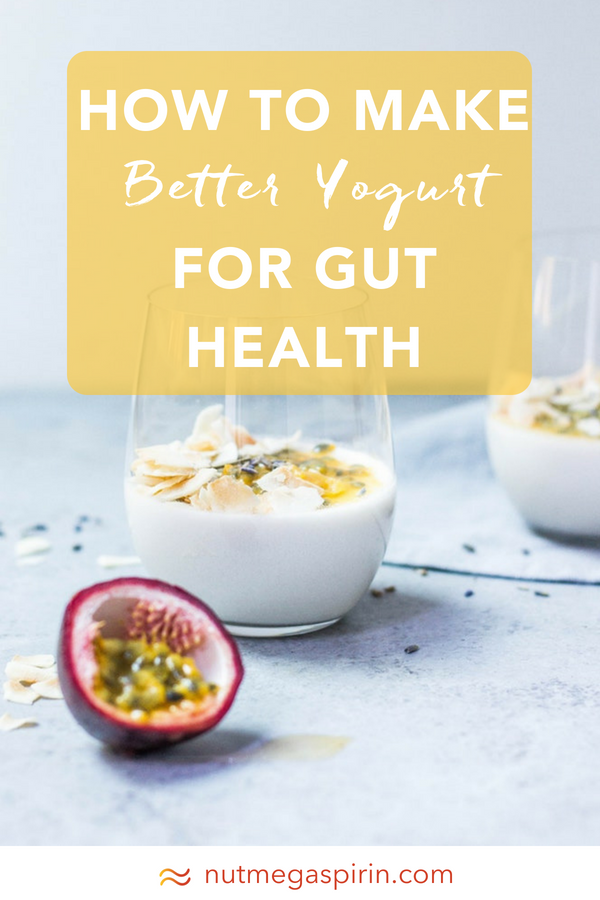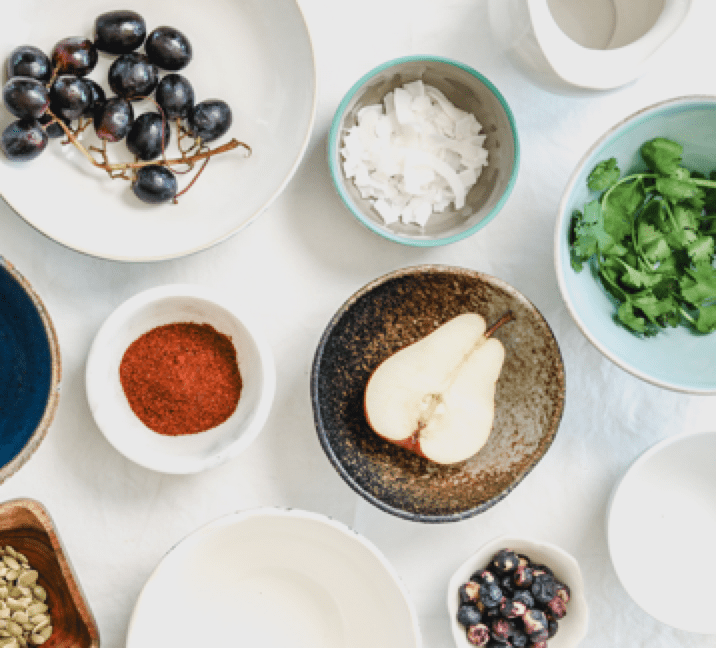How to Make 'Better Yogurt' for Gut Health

How It Works
It’s time to meet the ‘Better Yogurt’’. A cultured food that contains more than 5 times the amount of probiotic strains that are found within yogurt. This fermented food also colonizes in the gut. Hello, actual improved gut health!
You may have already caught onto which fermented food I am boasting about.
K E F I R .
Keh-feer, kee-fur, or kef-fur. It doesn’t really matter how you say it, as long as you include it!
All forms of kefir are made with a starter known as ‘kefir grains’, but don’t worry - these aren’t real grains, they just look like it. These ‘grains’ are actually made up of healthy bacteria and yeast.
While you can make kefir with both water and milk forms, this article will focus on the milk-based version to provide you with a creamy, dreamy yogurt alternative. But hey, if you're interested in water kefir - check out this complete how-to-guide for the simple fizzy drink with probiotic benefits.
Kefir can be used in the same ways as our regular ‘curdled milk’: pair your kefir with some powerhouse granola, add it to smoothies, top it on your favourite pancakes or incorporate kefir in your salad dressings or dipping sauces.
THE BENEFITS OF KEFIR
Why are we into fermentation again & what's the benefit? (In other words, why should I spend time making/using this?)
The magical art of food preservation has been practiced for thousands of years (it's not just a new 'trend'), the simple and natural process of lacto-fermentation encourages bacteria to feed on sugar/starch, creating lactic acid. The process is used to preserve foods and beverages in order to extend shelf life (which is why it was so popular thousands of years ago). However the process also creates beneficial enzymes, b-vitamins, minerals, omega-3 fatty acids, antioxidants and various strains of probiotics.
Fermentation has many 'pros', but the main thing to remember is that lactic acid promotes the growth of healthy intestinal flora which creates a healthy gut and stronger immune system!
HOW TO MAKE: DAIRY MILK KEFIR
TOTAL TIME: 3-7 days to activate new grains, then 1-2 days per batch
ACTIVE TIME: 5 minutes per batch
MAKES: 4 cups of milk kefir every 24-48 hours!
WHAT YOU NEED:
1 packet of dehydrated milk kefir grains (or you can find fresh milk grains from friends, family or kijiji)
Pasture-raised whole milk*
Glass mason jar or similar container
Eco-friendly unbleached coffee filter
Rubber band
Non-metal strainer (plastic or other non-reactive material)
HOW TO ACTIVATE DEHYDRATED KEFIR GRAINS:
STEP ONE: Empty the entire packet of dehydrated milk kefir grains into 1 cup fresh, cold pasteurized milk (don’t use raw milk for activation) and stir. Cover with a coffee filter or cloth secured by a rubber band and culture in a warm spot with a temperature of 68° to 85°F.
STEP TWO: Between hours 8 and 24, check the milk on an hourly basis. Is the milk thickening or changing texture slightly in less than 24 hours?
- Yes? As soon as you notice a change in the milk’s texture, strain out the grains and put them in fresh milk, increasing the amount of milk by 1/2 cup. Cover and culture as before.
- No? At the end of 24 hours, strain out the grains and put them into the same amount of fresh milk (never decrease the amount of milk). Cover and culture as before.
STEP THREE: Activation usually takes 3-7 days. By following the steps above, the size of your batch will increase in 1/2 cup increments up to a total batch size of 4 cups. If the milk thickens in less than 24 hours, remove some grains or add milk to keep your grains fed and happy. Your grains are activated!
HOW TO MAKE MILK KEFIR:
- Transfer the kefir grains to a clean glass mason jar with 4 cups of fresh milk.
- Cover the jar with a coffee filter or cloth secured by a rubber band. Place it in a warm spot that is around 68° to 85°F, to culture.
- Culture until the milk is slightly thickened and the aroma is pleasant. This generally takes 24 hours but may take less. Continue immediately to step 4.
- 4 After culturing is complete, separate the kefir grains from the finished kefir. Place the kefir grains in a new batch of o milk. Store the finished kefir in the refrigerator
NOTES:
-Choose the best milk available to you! Preferably pasture-raised, organic, non-homogenized or local/raw. Instead of cow’s milk, you can also use goat, buffalo or sheep's milk. See the next recipe for coconut milk kefir as a vegan option.
-At any stage of activation, if the finished product smells and tastes pleasant, you can drink it or cook with it. Otherwise, remove the grains from it and discard it.
-Milk kefir grains are hungry-living critters! Check them often and move them to fresh milk as soon as you see a texture change, or you risk off flavors and starved grains.
-Find the complete Q&A to making milk kefir here.
LEARN HOW TO MAKE COCONUT MILK/VEGAN KEFIR HERE: https://www.holisticole.com/blog/better-yogurt
What You’ll Need
Difficulty
nor hard Somewhat
challenging Very
challenging
Story
If I asked you to name some foods that have the potential to improve your gut health, you would likely start naming off some probiotic rich foods, a first though is yogurt.
But what a lot of people don’t know about yogurt; it’s positive effects on our gut flora are not as strong as we tend to believe. You see, while yogurt does contain probiotics - they aren’t quite as powerful as we have imagined.
ARE THE BENEFITS OF YOGURT OVER-HYPED?
Yogurt contains what is known as ‘transient bacteria’ (you can think of them like visitors); these bacteria follow the digestive process and are eventually evacuated from the body. While these are beneficial for keeping the digestive system clean and for providing a source of food for the friendly bacteria that call your gut home, the probiotics in yogurt do not actually populate the gut.
While yogurt can be a real blessing for regular bathroom trips - because yogurt only contains these 'transient' types of bacteria - you will only ever benefit from yogurt while you are eating it!
THE NUTRITIONAL BREAKDOWN OF KEFIR
While many of the nutrients found in kefir will depend on what type of milk is used, on average a 1-cup (250 ml) portion of whole milk kefir typically contains [3]:
Calories: 150 kcal
Carbohydrates: 12 grams
Protein: 10 grams
Fat: 8 grams (around 60% saturated)
Calcium: 300 milligrams (30% DV)
Vitamin D: 100 IU (25% DV)
Vitamin B2 (Riboflavin): .2 milligrams (19% DV)
Vitamin B12: 0.4 micrograms (16% DV)
Potassium: 263 mg (8%)
Vitamin A: 500 IU (10% V)
Vitamin C: 3.6 milligrams (7% DV)
Consuming fermented foods and beverages like kefir on a daily basis is an easy and delicious way to ensure you are getting in whole-food probiotics for gut health, and additionally you will be adding some more nutrient density to your day.
Benefits of kefir include, but are not limited to:
- Improved Gut Flora and Better Digestion
- Immune Support
- Bone Builder
- Combat IBS
- Improve Allergies & Asthma
- Decrease Inflammation
- Glowing Skin
- Improve Symptoms of Lactose Intolerance
- Supports Reaching & Maintaining a Healthy Weight
- Supports Healthy Detoxification






